History
In the late 1870s to the early 1910s, Cleveland's Euclid Avenue began to be dotted with several mansions that sprang up as Cleveland started to attract wealthy industrialist with its major businesses of coal, steel, iron, shipping, and oil. John D. Rockefeller, the undisputed king of Standard Oil and richest man in history it is alleged, Amasa Stone the Cleveland railroad baron father of Mather's wife, Charles F. Brush the inventor, George Worthington, Marcus A. Hanna, John Hay, Jeptha Wade, Charles E. J. Lang, and Mather all had homes built here by 1911. Euclid Avenue was once known as the "Most beautiful street in the world". [7] The concentration of wealth within this narrow strip of land has never been replicated again.
Schweinfurth was on something of a building spurt and designed more than fifteen homes for the Cleveland aristocracy, most of these homes are gone. A few still survive including Mather's, Case's near Case Western Reserve University in the University neighborhood, the Stager Beckwith near the Cleveland Clinic Main Campus, and the Parker-Hannifin House on the Cleveland State Campus which serves as the School of Graduate Studies at CSU.
The 15, 121 sq. ft. house was turned over to Cleveland State in 1967 after having passed through multiple hands following Mather's death in 1931 including the Cleveland Institute of Music and the Cleveland Automobile Club. [8] For decades the historic relic was furnished to serve as offices and official functions of the university until it was all but abandoned in the early 2010s. It was reopened to the general public in late 2015 after a $2.7 million rehab.
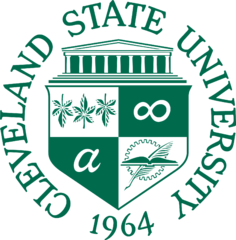
Cleveland State University (CSU) is a public research university in Cleveland, Ohio. It was established in 1964 and opened for classes in 1965 after acquiring the entirety of Fenn College, a private school that had been in operation since 1923. CSU absorbed the Cleveland-Marshall College of Law in 1969. Today it is part of the University System of Ohio, has more than 120,000 alumni, and offers over 200 academic programs. It is classified among "R2: Doctoral Universities – High research activity".

A mansion is a large dwelling house. The word itself derives through Old French from the Latin word mansio "dwelling", an abstract noun derived from the verb manere "to dwell". The English word manse originally defined a property large enough for the parish priest to maintain himself, but a mansion is no longer self-sustaining in this way. Manor comes from the same root—territorial holdings granted to a lord who would "remain" there.
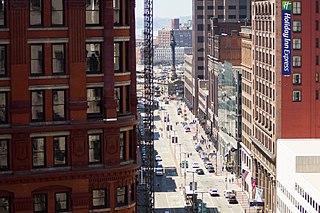
Euclid Avenue is a major street in Cleveland, Ohio. It runs northeasterly from Public Square in Downtown Cleveland, passing Playhouse Square and Cleveland State University, to University Circle, the Cleveland Clinic, Severance Hall, Case Western Reserve University's Maltz Performing Arts Center, Case Western Reserve University and University Hospitals Case Medical Center. The street runs through the suburbs of East Cleveland, Euclid, and Wickliffe, to Willoughby as a part of U.S. Route 20 and U.S. Route 6. The HealthLine bus rapid transit line runs in designated bus lanes in the median of Euclid Avenue from Public Square to Louis Stokes Station at Windermere in East Cleveland.
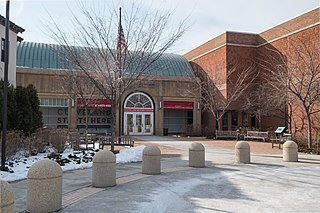
The Western Reserve Historical Society (WRHS) is a historical society in Cleveland, Ohio. The society operates the Cleveland History Center, a collection of museums in University Circle.

Squire's Castle is a shell of a building located in the North Chagrin Reservation of the Cleveland Metroparks in Willoughby Hills, Ohio.

Downtown Cleveland is the central business district of Cleveland, Ohio. The economic and symbolic center of the city and the Cleveland-Akron-Canton, OH Combined Statistical Area, it is Cleveland's oldest district, with its Public Square laid out by city founder General Moses Cleaveland in 1796.
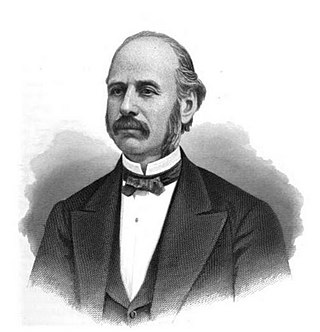
Amasa Stone, Jr. was an American industrialist who is best remembered for having created a regional railroad empire centered in the U.S. state of Ohio from 1860 to 1883. He gained fame in New England in the 1840s for building hundreds of bridges, most of them Howe truss bridges. After moving into railroad construction in 1848, Stone moved to Cleveland, Ohio, in 1850. Within four years he was a director of the Cleveland, Columbus and Cincinnati Railroad and the Cleveland, Painesville and Ashtabula Railroad. The latter merged with the Lake Shore and Michigan Southern Railway, of which Stone was appointed director. Stone was also a director or president of numerous railroads in Ohio, New York, Pennsylvania, Indiana, Illinois, Iowa, and Michigan.
Cleveland State University College of Law is the law school of Cleveland State University, a public research university in Cleveland, Ohio. The school traces its origins to Cleveland Law School, which merged in 1946 with the John Marshall School of Law to become Cleveland-Marshall Law School. When the school affiliated with Cleveland State University in 1969, it became Cleveland–Marshall College of Law. In 2022, the university dropped Marshall's name from the school due to his history of owning slaves.

Wick Park Historic District is a historic neighborhood on the north side of Youngstown, Ohio, with Wick Park as its centerpiece. During the first half of the 20th century, the residential district surrounding Wick Park included some of the city's most affluent neighborhoods. The district is "roughly bounded by 5th Ave, Park Ave, Elm St. and Broadway".
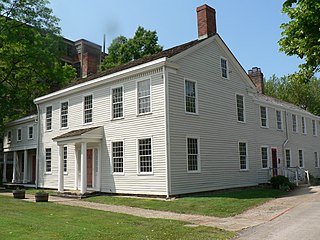
The Dunham Tavern, also known as the Dunham Tavern Museum, is the oldest building in Cleveland, Ohio, located at 6709 Euclid Avenue. Rufus and Jane Pratt Dunham built their first home on the site in 1824, and the existing taproom was built in 1842. It is believed to be the first building constructed on Euclid Avenue east of East 55th Street and the first frame house on the street. It later became a stagecoach stop and tavern.

Mather House, formally named Flora Mather House, is a college building named for Flora Stone Mather at Case Western Reserve University in Cleveland, Ohio. It was built as a dormitory for the Flora Stone Mather College for Women of Western Reserve University, and currently houses classrooms and offices for the university's departments of art history, classics, history, and political science.

J. Milton Dyer was a prominent Cleveland, Ohio architect.

Charles Frederick Schweinfurth was an American architect in Cleveland, Ohio. His brother Julius Schweinfurth was also an architect and they did some projects as a partnership.
Coburn & Barnum was a Cleveland, Ohio architectural firm from 1878 to 1897. It was established by Forrest A. Coburn and Frank Seymour Barnum. The firm also included W. Dominick Benes and Benjamin S. Hubbell for one year and was known as Coburn, Barnum, Benes & Hubbell until 1897, when Benes and Hubell departed to establish their own firm Hubbell & Benes. After their departure and Coburn's death, Barnum formed F. S. Barnum & Co. with Albert Skeel, Harry S. Nelson, Herbert Briggs, and Wilbur M. Hall. Barnum also served as consulting architect to the Cleveland Board of Education. He retired in 1915 having designed more than 75 school buildings, the Caxton Building (1903) and the Park Building (1904), an early example of reinforced concrete floor slabs. The firm continued after his 1915 retirement under the name of Briggs & Nelson.

Hough is a neighborhood situated on the East Side of Cleveland, Ohio. Roughly two square miles, the neighborhood is bounded to Superior and Euclid Avenue between East 55th and East 105th streets. Placed between Downtown Cleveland and University Circle, Hough borders Fairfax and Cedar–Central to the South and Glenville and St. Clair–Superior to the North. The neighborhood became a target for revitalization during the mid-20th century, after the 1966 Hough Riots.

The Campus District is a Downtown Cleveland, Ohio district that includes the campuses of Cleveland State University, St. Vincent Charity Medical Center, and the Cuyahoga Community College (Tri-C) Metro Campus. Definitions of the district vary. According to the Cleveland City Planning Commission, the district is bounded by Payne Avenue to the north, East 17th Street to the west, and Interstate 90 to the south and east, forming the boundary between Downtown and Cleveland's Central neighborhood. However, the Campus District association places the western boundary of the district to East 18th Street and the eastern boundary further east, to East 30th Street, including Tri-C, with Interstate 77 to the south.
The Cleveland Landmarks Commission is responsible for determining whether buildings, sites or historic districts are eligible for designation as landmarks in the city of Cleveland, Ohio. As Cleveland has many historic streets, districts, and buildings the commission is charged with weeding out what buildings, districts, and streets are of definite interest to the people of Cleveland, Ohio and the nation of the United States in general. Two of the oldest buildings in the city that are listed on the Landmarks Commission are the 1824 Dunham Tavern Museum and the 1855 Old Stone Church located on Public Square.
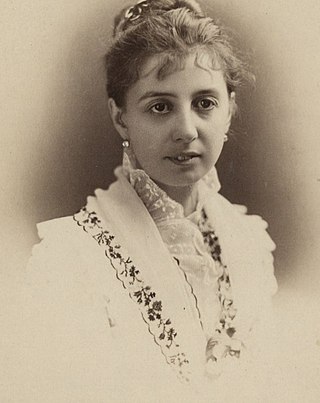
Flora Stone Mather was a prominent philanthropist and advocate supporting religious, social welfare, and educational institutions in Cleveland, Ohio.Her leadership and generosity, directed toward promoting the education of women, led to Western Reserve University's College for Women being renamed in 1931 as the Flora Stone Mather College for Women.

Henry Chisholm was a Scottish American businessman and steel industry executive during the Gilded Age in the United States. A resident of Cleveland, Ohio, he purchased a small, struggling iron foundry which became the Cleveland Rolling Mill, one of the largest steel firms in the nation. He is known as the "father of the Cleveland steel trade".

The Maxine Goodman Levin College of Urban Affairs (Levin) is an accredited college of urban studies, public administration, urban planning, environmental studies, and nonprofit management at Cleveland State University located in Cleveland, Ohio. The Levin College offers undergraduate, graduate, and doctoral degrees, as well as professional development programs. Its urban policy research centers and programs provide communities with decision-making tools to address their policy challenges. The Levin College is recognized for offering highly ranked programs in urban policy, local government management, nonprofit management, and public management and leadership.



















